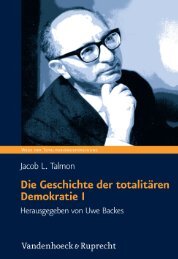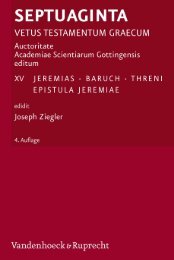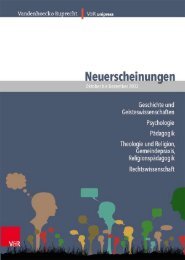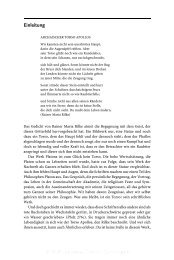Counsel and Conscience
Counsel and Conscience
Counsel and Conscience
You also want an ePaper? Increase the reach of your titles
YUMPU automatically turns print PDFs into web optimized ePapers that Google loves.
Benjamin T. G. Mayes, <strong>Counsel</strong> <strong>and</strong> <strong>Conscience</strong><br />
Casuistry 19<br />
1967b, 12–13, 117). 21 Anglican casuistry especially had much in common with<br />
the Puritan tradition of casuistry. “English casuists wrote with the intention<br />
‘not of correcting the work of their predecessors but of amplifying it.’ Bishops<br />
drew from the work of ‘puritans’ <strong>and</strong> vice versa” (Vallance/Braun: 2003, xii).<br />
The Reformed had their casuistry as well, beginning with William Perkins’s<br />
Whole Treatise of the Cases of <strong>Conscience</strong> (1606). 22 Writing in the mideighteenth<br />
century, the Lutheran theologian Johann Georg Walch listed<br />
Heinrich Alsted, William Ames, Perkins, Joseph Hall, Jeremy Taylor, Robert<br />
S<strong>and</strong>erson, <strong>and</strong> Andreas Rivetus as the chief Reformed casuists (Walch: 1758,<br />
2:1132–34). 23 Latin <strong>and</strong> German translations of their works were known in<br />
Germany, being printed not only in Reformed cities but in a few Lutheran<br />
ones as well (Alsted: 1621; Ames: 1630; Perkins: 1603; 1608; 1690; Hall: 1677;<br />
Taylor: 1705; S<strong>and</strong>erson: 1674; Rivetus: 1632).<br />
Why was this casuistry literature not written <strong>and</strong> published among Protestants<br />
until the beginning of the seventeenth century? It has been suggested<br />
that casuistry seemed inseparable from the confessional, the abuses of which<br />
had been an argument that Protestants used against the Roman Catholic<br />
Church; also, a work of casuistry is a large <strong>and</strong> difficult task – too much for<br />
the sixteenth-century theologians who chose to spend their time in the controversies<br />
of the day (Wood: 1952, 38; cf. Jonsen/Toulmin: 1988, 158–60). Yet<br />
eventually casuistry was written. Perhaps the moral theologies <strong>and</strong> systematic<br />
presentations of ethics were not flexible nor sensitive enough to address all<br />
situations; in an age of conflict, ethical behavior also became controversial;<br />
new developments in life arose which congregations were not able to judge on<br />
their own (Gass: 1881, 147). 24 These are the kinds of answers that have been<br />
�� On the issue of casuistic method, Vallence <strong>and</strong> Braun (2003, xvii–xviii) <strong>and</strong> Franklin (2001, 84)<br />
characterize Anglican casuistry as probabilioristic (concerning which term, see below, chapter 1.4).<br />
�� The first part had been published in 1604. The treatise was quite popular, experiencing at least nine<br />
editions between 1606 <strong>and</strong> 1651. Another treatise on conscience appeared earlier in German-speaking<br />
l<strong>and</strong>s (Perkins: 1603). Margaret Sampson (1988, 98) says that there was an English Protestant casuistry<br />
written in 1523. But this early casuistry was isolated <strong>and</strong> not part of a major effort at publishing<br />
casuistry, such as there was among Lutherans, Anglicans, <strong>and</strong> Puritans in the seventeenth century.<br />
James F. Keenan (2003) argues that The Whole Treatise is not truly a “casuistry,”but is rather a directory<br />
in the first part <strong>and</strong> a summary of cases thereafter. Keenan’s observation, that there were several possible<br />
predecessors for Perkins, is helpful, but his narrow usage of the word “casuistry” will not prevent<br />
us from using it in a wider sense.<br />
�� On Alsted, see Stone (2000, 76, 88–89). Keith Sprunger (1972, 161) lists the main English Puritan<br />
casuists as Greenham, Perkins, Ames, <strong>and</strong> Richard Baxter, <strong>and</strong> the main Anglican casuists as Jeremy<br />
Taylor, Joseph Hall, Robert S<strong>and</strong>erson, <strong>and</strong> John Sharp. Richard Muller (1980, 312) adds John Downham.<br />
�� Gass’s suggestions here, which he applies to both Reformed <strong>and</strong> Lutheran casuistry, are not completely<br />
satisfying. See below, chapter 1.6.<br />
© 2011, V<strong>and</strong>enhoeck & Ruprecht GmbH & Co. KG, Göttingen<br />
ISBN Print: 9783525550274 — ISBN E-Book: 9783647550275

















